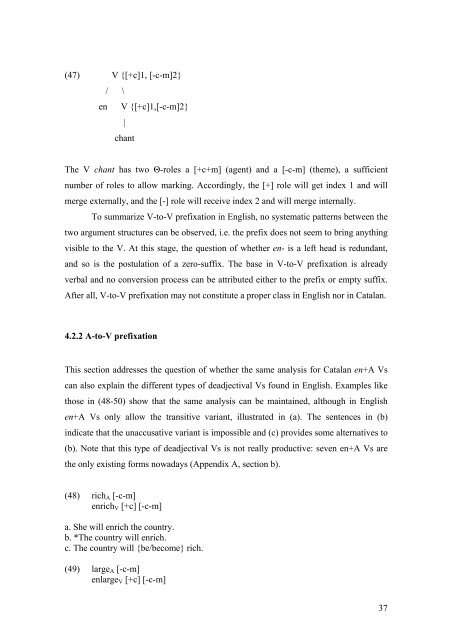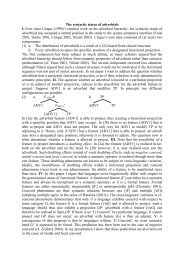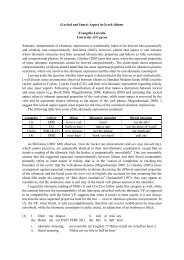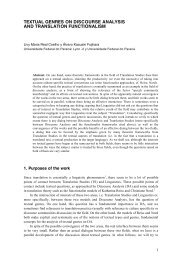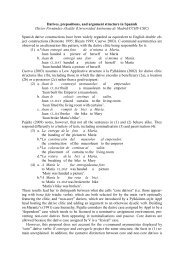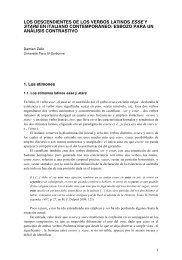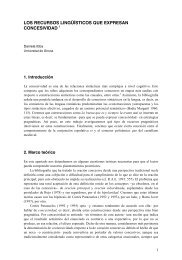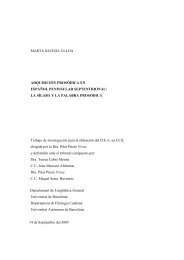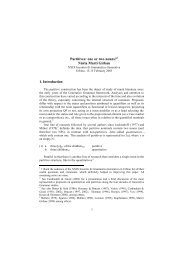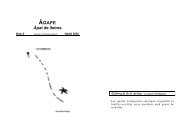Prefixation in English and Catalan - Departament de Filologia ...
Prefixation in English and Catalan - Departament de Filologia ...
Prefixation in English and Catalan - Departament de Filologia ...
Create successful ePaper yourself
Turn your PDF publications into a flip-book with our unique Google optimized e-Paper software.
(47) V {[+c]1, [-c-m]2}<br />
/ \<br />
en V {[+c]1,[-c-m]2}<br />
|<br />
chant<br />
The V chant has two Θ-roles a [+c+m] (agent) <strong>and</strong> a [-c-m] (theme), a sufficient<br />
number of roles to allow mark<strong>in</strong>g. Accord<strong>in</strong>gly, the [+] role will get <strong>in</strong><strong>de</strong>x 1 <strong>and</strong> will<br />
merge externally, <strong>and</strong> the [-] role will receive <strong>in</strong><strong>de</strong>x 2 <strong>and</strong> will merge <strong>in</strong>ternally.<br />
To summarize V-to-V prefixation <strong>in</strong> <strong>English</strong>, no systematic patterns between the<br />
two argument structures can be observed, i.e. the prefix does not seem to br<strong>in</strong>g anyth<strong>in</strong>g<br />
visible to the V. At this stage, the question of whether en- is a left head is redundant,<br />
<strong>and</strong> so is the postulation of a zero-suffix. The base <strong>in</strong> V-to-V prefixation is already<br />
verbal <strong>and</strong> no conversion process can be attributed either to the prefix or empty suffix.<br />
After all, V-to-V prefixation may not constitute a proper class <strong>in</strong> <strong>English</strong> nor <strong>in</strong> <strong>Catalan</strong>.<br />
4.2.2 A-to-V prefixation<br />
This section addresses the question of whether the same analysis for <strong>Catalan</strong> en+A Vs<br />
can also expla<strong>in</strong> the different types of <strong>de</strong>adjectival Vs found <strong>in</strong> <strong>English</strong>. Examples like<br />
those <strong>in</strong> (48-50) show that the same analysis can be ma<strong>in</strong>ta<strong>in</strong>ed, although <strong>in</strong> <strong>English</strong><br />
en+A Vs only allow the transitive variant, illustrated <strong>in</strong> (a). The sentences <strong>in</strong> (b)<br />
<strong>in</strong>dicate that the unaccusative variant is impossible <strong>and</strong> (c) provi<strong>de</strong>s some alternatives to<br />
(b). Note that this type of <strong>de</strong>adjectival Vs is not really productive: seven en+A Vs are<br />
the only exist<strong>in</strong>g forms nowadays (Appendix A, section b).<br />
(48) richA [-c-m]<br />
enrichV [+c] [-c-m]<br />
a. She will enrich the country.<br />
b. *The country will enrich.<br />
c. The country will {be/become} rich.<br />
(49) largeA [-c-m]<br />
enlargeV [+c] [-c-m]<br />
37


